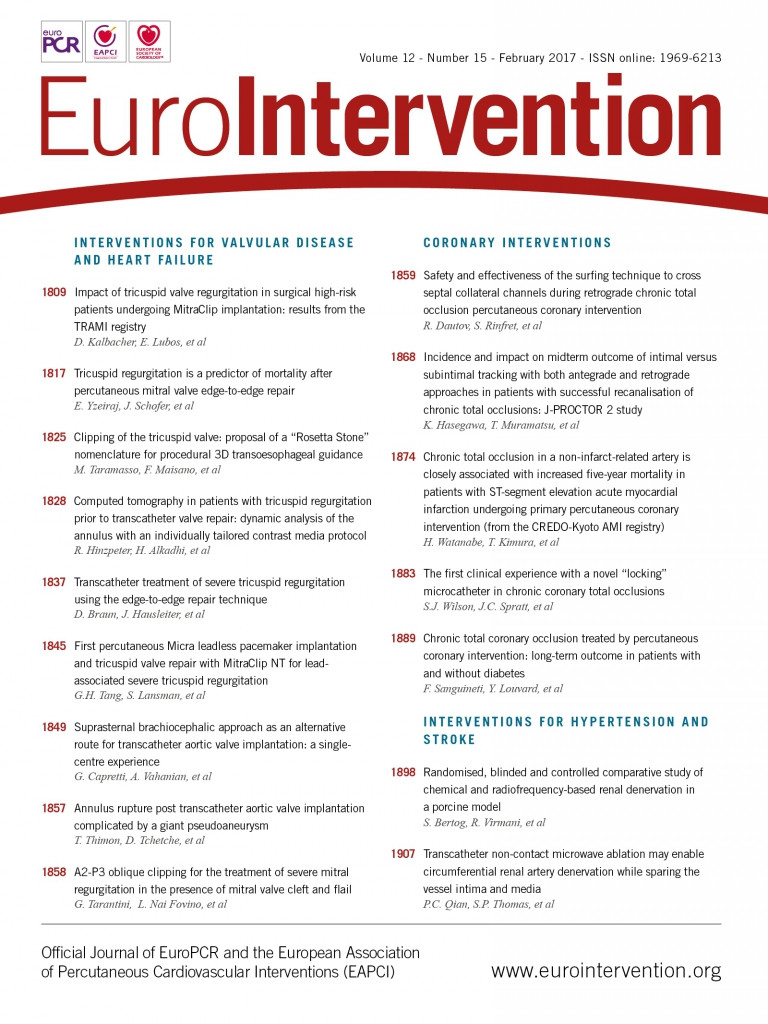
In this issue of EuroIntervention, three papers present different aspects relevant to the discussion of the role of percutaneous coronary intervention (PCI) in the treatment of chronic total coronary occlusions (CTO). First, the analysis from the Japanese acute MI registry underscores the impact of CTO on prognosis in the context of coronary artery disease1. This supports previous reports on the same subject2,3, even though we still have no evidence from randomised trials, that treating the CTO might influence prognosis. However, most non-randomised studies point to the benefit of revascularisation of a CTO in terms of improvement of symptoms and function4. On the other hand, there is no evidence that a CTO is a more benign coronary lesion than a high-grade stenosis, and considering CTO as a different class of lesions in current guidelines is based rather on the historic observation of low PCI success rates than on any clinical evidence. This low success rate, however, can be overcome by modern CTO strategies, and therefore CTO should be considered a target for PCI like any other lesion, except for the need for expert technique and experience which goes beyond what is required for performing PCI in non-CTO lesions5.
Two of the papers in this journal deal with these new techniques available for the treatment of CTO6,7. The development of CTO PCI over the past decade has been driven by the availability of new dedicated wires and microcatheters, and their application in new techniques, mainly the retrograde approach8, but also the controlled re-entry from the subintimal space9. Both papers focus on the retrograde approach, one on the start of the procedure, the passage of the collateral pathway6, and one on the conclusion of the procedure and the outcome with respect to the intimal or subintimal wire passage7.
The selection and passage of the collateral is the initial step in the retrograde procedure. Many patients will have several parallel pathways, but some have only limited collateral options10; therefore, a careful approach to collateral passage is advised. The controversy behind the paper by Dautov et al, the way to cross a collateral by so-called “surfing” as opposed to a more controlled passage with selective collateral injection, is not actually resolved by this paper. There is no comparison to selective injections into the collateral, so we cannot know which approach is really “better”. However, the fact that one fourth of the collaterals were damaged during the surfing approach is rather worrying and contradicts the title which suggests the safety of that approach. The surfing of septal collaterals was used initially because the available wires were regular soft wires such as the Fielder™ FC (ASAHI Intecc, Aichi, Japan) or HIGH-TORQUE WHISPER (Abbott Vascular, Santa Clara, CA, USA), with limited tip control. Nowadays, the dedicated wires for collateral passage are Sion™ wires (ASAHI Intecc). These have much improved wire tip control, increasing considerably the success in passing collaterals, as well as lower tip strength which offers a safer way to pass epicardial collateral connections. To apply the advantage of these wires it is important to know the course of the target collateral. If this is clearly visible on a reference image, we do not need further selective injections into the collateral. However, if there are tortuous segments and branching within the collateral course, a selective injection will help the further progress of the wire. It is difficult to obtain objective evidence regarding the two approaches and hard to randomise. Even if you do, operators will still have their personal preference and different expertise, and that would influence the outcome of such a comparison.
The paper by Hasegawa et al7 is a follow-up of a previous analysis11, in which they compare the impact of the frequency of subintimal wire pathways in both the antegrade and retrograde approach on long-term lesion recurrence. The observation of a higher recurrence with subintimal pathways, especially in the retrograde approach, challenges the statement of a group of operators from the USA and the UK that the so-called hybrid approach, which applies liberal dissection of the artery if the lesion length is beyond 20 mm both in the antegrade and retrograde approach, would lead to a good long-term outcome irrespective of the extent of the subintimal dissection. There are only limited follow-up data of this hybrid algorithm, but some angiographic data in fact point to a high lesion recurrence12. We certainly need more follow-up data in this field, but it is essential to have angiographic follow-up to answer the issue, as clinical follow-up may underestimate the problem. In long, complex CTO, it is very hard to avoid any extent of subintimal pathway, but it should be avoided or at least limited as much as possible.
The title of this editorial raises the issue of differences in the approach to PCI of CTO, and the term “traditional” points to these differences. In my view, this is an unfortunate and unnecessary debate on the technical performance of the procedure, where as in all fields of medicine there will be variations in the approach. If we accept that a traditional approach is based on the exploration of the benefits of manipulating modern wires to advance through an occlusion rather than resorting to a destruction of the vessel anatomy by using dissection and re-entry techniques in a high percentage, then I would support the traditional approach. In particular, ignorance of the classic parallel wire technique with new controllable wires is a shortcoming of the hybrid algorithm. However, even a traditional approach does not ignore the benefit of the re-entry technique in certain situations, and we should all agree that we need a well laid-out strategy before we engage any CTO, with primary and secondary strategies, which need to be applied swiftly if one approach fails, and not to get stuck in a failure mode.
Rather than discuss the subtleties of the technique, we should join forces in convincing the interventional community and the general physician that a patient with a CTO deserves the same expert use of modern PCI techniques as any patient with a symptomatic non-CTO coronary lesion.
Conflict of interest statement
The author has no conflicts of interest to declare.

